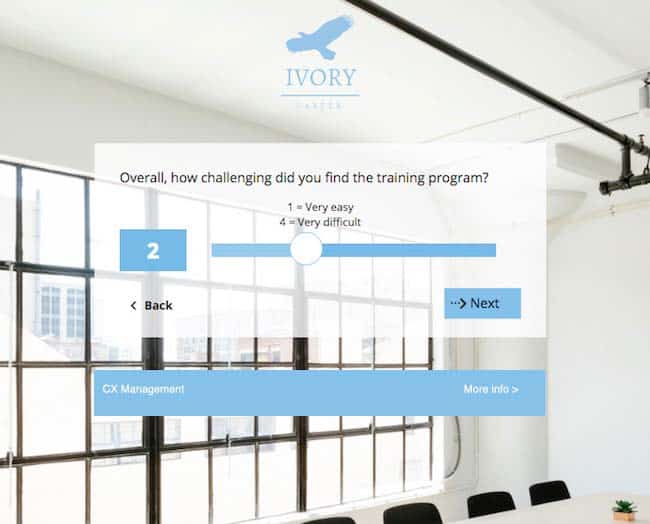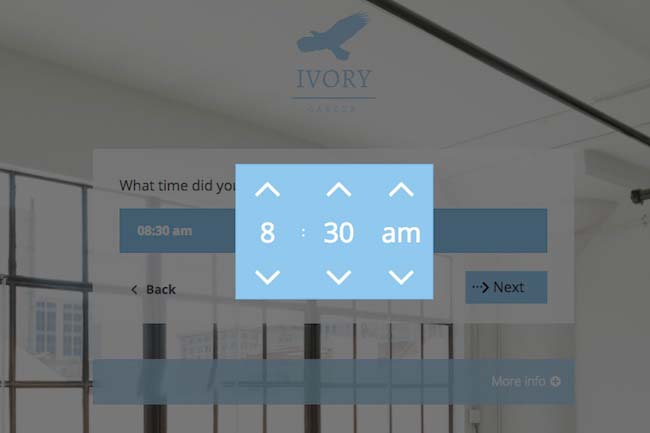If you work with a training centre or organization, you know how important it is to assess the quality your training programs. Over 90% of organizations rely on these evaluations.
In this article, we’ll explain the importance of satisfaction surveys, as well as offer more than 40 examples of questions to include, covering all of the various different aspects of your program.
Why send out a satisfaction survey after a training program?
The goal of these surveys is to find out the opinions of your training program’s participants, and determine how satisfied they were with the training they received. Getting feedback from participants is the best way to continuously improve the organization, structure and content of your training programs.
By sending out a survey after a training program, organizers can identify any shortcomings and determine areas for improvement, as well as find out if any learning needs were not covered by the content of the current training program. These surveys also enable organizers to keep in touch with participants.
What aspects of the training program should be evaluated?
When implementing an evaluation framework for your training program, it is very important to determine the goals of your survey in advance. What do you want to find out from your participants? The structure of your survey, its format and the questions that are asked all depend on the type of information you would like to collect.
Overall, there are 5 general areas that can be evaluated in a post-training survey:
- The setting and resources offered by the training centre, including the location, facilities and teaching materials used.
- Teaching methods, including content that is presented during the training sessions, learning activities, etc.
- Facilitators and participants of the training program.

- Organizational elements, such as registration, the length of the training program, and if applicable, other aspects such as food and lodging.
- How the program benefits its participants: Have the learning objectives been achieved? Have participants been able to use the skills they learned during the training program? Were they able to find a new job after participating in the program?
When should you send out your satisfaction survey?
It’s very important to reflect on the best time to send out your survey. Some questions should not be asked immediately after the program. For example, you shouldn’t ask participants if they have benefitted from participating in the training program if you send the survey two days after the program has ended. Your timing for the survey should depend on the types of questions you would like to ask.

However, the vast majority of questions can indeed be asked immediately after the program has ended. For this reason, we suggest sending a survey right after the program – a second (follow-up) survey can be sent out a few weeks or months later.
Please note: evaluations of training programs often take place at the end of the session. Because the trainer(s) are usually present, this is not the best time for a satisfaction survey. It’s better to send out your survey via digital channels, after participants have left the training facility.
Let’s take a look at some examples of questions that you can include in your survey. These questions are organized according to the different aspects to be evaluated: the setting and resources, teaching methods, facilitators and participants, organization, and benefits of the training program.
4 questions to evaluate how satisfied your participants were with the program’s setting and resources
To begin, here are a few questions that you can ask participants regarding the material resources offered during the training program. You can, of course, change the structure of these questions and answers, as well as of all the questions that follow.
For example, if a question begins with “How did you feel about…?”
And offers the following possible answers: Very satisfied, somewhat satisfied, somewhat unsatisfied, very unsatisfied
This can be changed to:
“On a scale of 1 to 10, how did you find…?”
1. Overall, how did you find the training facilities?
Some training providers go even further with this question, asking participants about the accessibility, lighting and temperature of the facilities.
2. What did you think of the training environment?
The training environment (including all facilities, especially the classrooms where the training sessions take place) plays an important role in participants’ perception of the program’s quality.

3. How satisfied were you with the teaching materials used during the program?
This is a general question that allows you to evaluate all of the teaching materials used: documents, booklets, handouts, content shown on an overhead projector, websites, etc. You can also add additional details to evaluate each specific type of teaching materials.

4. Have you consulted the training program’s website?
This is a good question to ask if the program’s website is part of the training materials available to participants. This can be a yes or no question, or you can ask participants how often they visit the site: every day, once a week, never, etc.
You can also go even further and ask participants about the different elements of the website: the overall presentation, layout, navigation, and the information available on the site.
12 questions that can be used to evaluate participant satisfaction regarding teaching strategies
Here are a few questions you can use to evaluate the program’s structure, approach, content and teaching strategies.
1. Overall, how challenging did you find the training program?

2. What did you think of the pace of the training sessions?
3. What did you think of the length of the training sessions?
4. In your opinion, were the learning objectives clearly stated at the beginning of the session?
5. Which section of the training program seemed the most pertinent for you?
The list of possible answers should include the names of the different modules/sections of the training program that the respondent participated in.
6. What did you think of the balance between the theoretical and practical elements of the program?
Training programs usually include both theoretical instruction as well as opportunities for participants to apply what they have learned. A training program’s quality partly depends on the facilitators’ ability to balance these two elements.

7. How did you feel about the language used by your trainers?
To provide high-quality instruction, a trainer must make the course content easy to understand, as well as ensure that the vocabulary they use is well-adapted to the context of the training program.
Some possible answers could be: Too simple, ideal, too technical.
8. What did you think of the program’s co-ordination?
Training programs are sometimes facilitated by more than one trainer. When this is the case, the effectiveness of the training provided depends partly on how well the trainers have co-ordinated their teaching, with each of them taking on specific tasks.
9. What did you think of the progression from one section of the program to the next?
The three questions that follow will allow you to evaluate each of the sections or modules of the training program.
10. Which of the program’s modules would you have liked to see developed further?
11. Which module were you the least interested in?
12. Overall, how would you evaluate the teaching strategies used?
4 questions to evaluate the program’s trainers and participants
These questions allow participants to evaluate their trainers, as well as the other participants in the program. Some of these questions about the program’s trainers can also be categorized in the previous section (evaluating teaching methods).
1. How would you evaluate the skill levels of your trainers?

2. How knowledgeable did you find your trainers to be on the subjects discussed during the program?
On a scale of 1 to 10, how approachable did you find your trainers?
3. How would you evaluate the skill levels of the other participants in the training program?
This question allows you to determine whether or not participants have the same skill levels, as training is generally more effective if this is the case.
4. On a scale of 1 to 10, how would you evaluate the program’s interactivity?
5 questions on the organizational aspects of the training program
These questions will let you evaluate the organizational and logistical elements of the program, including information that is sent out, waiting periods, the registration process, etc.
1. Did you have any difficulty accessing information about the training program?
This question can be followed by an additional question, with a free response section, that asks participants which information they had trouble finding.
2. Did you have any difficulty registering for the training program?
Again, an additional question with a free response section is necessary.
3. How did you feel about the dates of the training sessions?
4. How did you feel about the times of day that the training sessions took place?
By requesting participants’ opinions on scheduling throughout the entire program, you can cross-analyze feedback on the scheduling of your various different training programs.

5. What did you think of the location of the training facilities?
8 questions on the benefits that the training program has offered your participants
With these questions, you can determine how your participants have benefitted from participating in your training program.
1. Why did you sign up for the training program?
An in-depth analysis is essential here, in order to better understand the motivations of your participants.
2. Was the training you received in line with your expectations?
3. Would you recommend this training program to your colleagues?
If you’re familiar with surveys, you’ll likely have noticed this reference to the Net Promoter Score

4. In your opinion, have the objectives of the training program been accomplished?
5. Did the training program include all of the elements that you expected it to?
6. Do you feel that this training program has enabled you to fill in any knowledge gaps that you had?
7. Did this program enable you to achieve the professional goals that you set for yourself?
8. Would you be interested in participating in another training program?
Depending on the answers you receive, you could then suggest an appropriate training program from your catalogue via an automatic e-mail.
Skeepers CX is an excellent option for sending out online surveys. Our solution enables you to draft your surveys, use your training centre’s design template, and send out your survey via the distribution channel of your choice: e-mail, text message, telephone, mobile app, etc. The data that you collect via Skeepers can be sent to your dashboard, allowing you to create well-structured and effective reporting on the feedback you receive. You can then share these reports with your collaborators, or with the HR department of the company whose employees participated in your training program.
<!–[if lte IE 8]><![endif]–> hbspt.cta.load(20304540, ‘cb2d0916-f405-47e9-bb18-4064b993938a’, {“useNewLoader”:”true”,”region”:”na1″});
hbspt.cta.load(20304540, ‘cb2d0916-f405-47e9-bb18-4064b993938a’, {“useNewLoader”:”true”,”region”:”na1″});


















